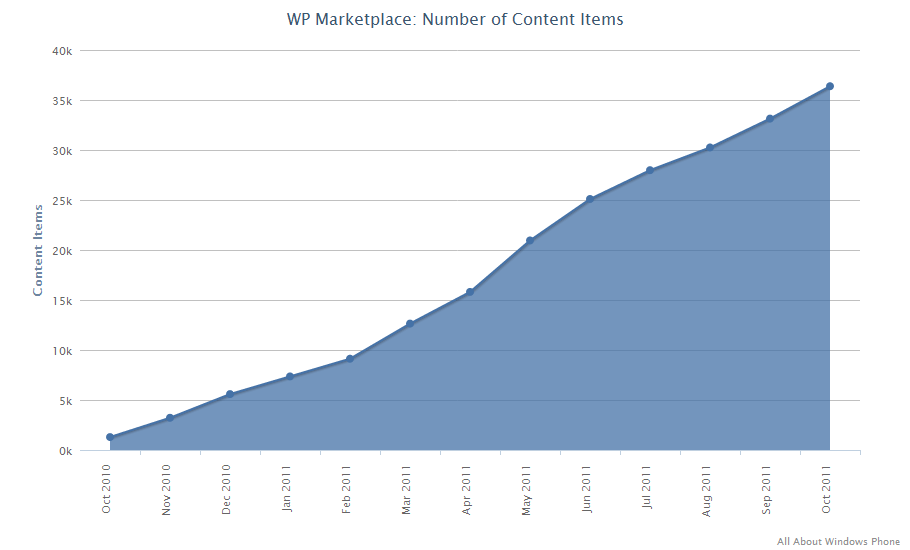At the time of writing 36,380 items have been published. There are currently 9,781 publishers represented in the Windows Phone Marketplace. You can see all of the applications and games in our Apps & Games section.
The graph below shows the growth in the total number of applications published to the Windows Phone Marketplace over the last year.

In common with other application stores, the total number of published items is not the same as the number of items available to a consumer. Of the 36,380 items published to the Marketplace, just over 5,000 are no longer available (removed by Microsoft or withdrawn by the publisher). In addition, some items are only available in select markets. This means the number of available items to a consumer, in a given market, is lower than the number of published items. The current approximate figures are: US (30,500), UK (29,000), France (28,400), Spain (27,900), Italy (27,800), Germany (27,700), Australia (27,700), Mexico (26,900) and Singapore (26,900).
An average of around 100 content items are added each day, although there is a significant amount of variation. In recent weeks, this number has started to creep upwards, roughly co-inciding with the launch of Mango. The end of the quiet summer season may also be a factor. For example, 1,240 content items were added to the Windows Phone Marketplace last week. The graph below shows the number of content items added each week for the last three months.

Comparison to competing application stores
There are more than 500,000 items in Apple's App Store, 300,000 in Google's Android Marketplace and 50,000 in Nokia Store. Windows Phone Marketplace is in fourth place, ahead of Blackberry App Word and a raft of smaller application stores.
The majority of these app stores hold items for more than one device or platform configuration. The most obvious of these is the divide between tablets and phones, but this can also apply to platform versions. For example, Nokia Store covers MeeGo, Series 40, and every version of Symbian.
In the case of the Nokia Store, a more meaningful comparison is to look at Symbian^3 applications - for which the total number of items is just over 25,000 (18,000 if you exclude wallpapers, themes and ringtones).
The total number of apps in each store holds a lot of perception weight and there's no doubt iOS and Android are a long way ahead in terms of application availability. However, an interesting comparison is to look at numbers for the first year of each of the application stores.
In the first year (July 2008 - July 2009) of the Apple App Store, approximately 65,000 items were published. Note, however, that the Apple App Store launched a year after the original iPhone became available. The Android Marketplace (November 2008 - November 2009) reached approximately 20,000 items after the first year. Finally, the Nokia Store (also launching for existing devices) reached approximately 15,000 items in its first year (June 2009 - June 2010).
The market for, and awareness of, apps has exploded in the last few years, which means it should be easier for Windows Phone to have a bigger first year than its competitors. Nonetheless, the first year comparison is encouraging for Windows Phone Marketplace, suggesting it is growing at a healthy rate.
For the Windows Phone Marketplace, much will now depend on what happens in the next year. Both iOS and Android grew rapidly in their second year, reaching 230,000 and 100,000 items respectively. With Nokia devices on the horizon, there's a big opportunity for Windows Phone to follow suit.
Statistics make for an easy comparison, but it is worth remembering that the total number of applications is less important than their quality. Having a certain number of applications makes for good marketing material, I'd suggest the psychological barrier for this is 100,000 apps. Ultimately though, for a good consumer experience, having the right applications is more important than any particular statistic.
